147 items found
Page 2 of 2
-
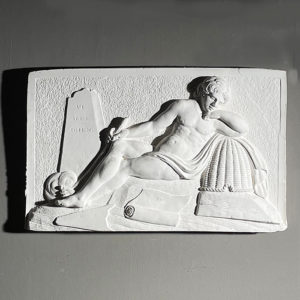
An English plaster relief plaque of a lachrymose beekeeper,
£175An English plaster relief plaque of a lachrymose beekeeper,
the prone male, attired in only a drape and holding a staff, shedding a tear as he leans on a beehive, the background carved in bas-relief with a monument engraved "VI SEES IGIEN", on the ground a unfurled manuscript entitled "DIGESTA F.F."£175 -
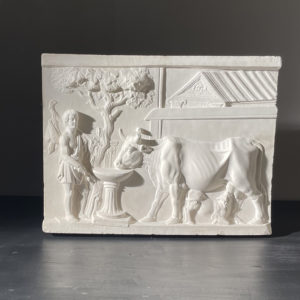
An English plaster relief plaque of a Cowherd together with a Cow and suckling calf,
£175An English plaster relief plaque of a Cowherd together with a Cow and suckling calf,
the standing male, with a brace of pheasant hanging from his shouldered staff, the cow drinking from a sculpted font, the background carved in bas-relief with a naturalistic tree and domestic Roman buildings,£175 -
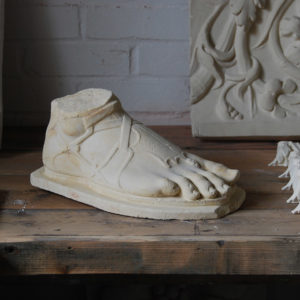
A plaster cast of a classical foot
£170A plaster cast of a classical foot
the right foot with a strapwork sandle on a low plinth/sole,£170 -
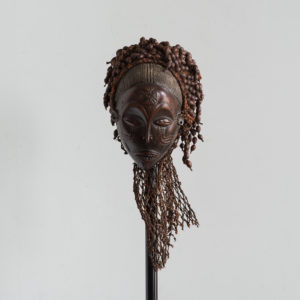
Tchokwe Pwo mask,
£165Tchokwe Pwo mask,
The Pwo is a classic Chokwe mask genre that honours their founding female ancestries as guardians of fertility and procreation. Chokwe masks were made and worn by men, often performed during the celebrations that mark a completion of initiation into adulthood and with means to honour women who had survived the difficulty of childbirth. The occasion is also said to mark the dissolution of intimate bonds between mothers and their sons, which may be represented through the tear carvings and motifs seen on the face. Further, facial scarification as seen on this mask would have been used to make the person less desirable to the spirit of death, and in women specifically would mark the birth of a baby boy.£165 -
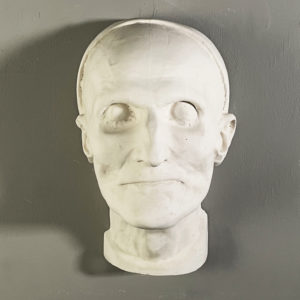
An English cast plaster death-mask of the Versailles head gardener
£165An English cast plaster death-mask of the Versailles head gardener
from the 18th Century original,£165 -
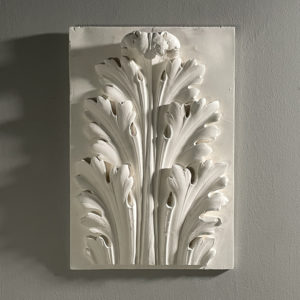
A cast plaster acanthus leaf relief
£165 -
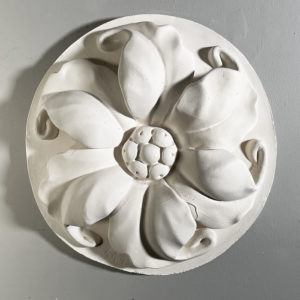
A cast plaster roundel relief of a stylised clematis flowerhead
£160A cast plaster roundel relief of a stylised clematis flowerhead
the six overlapping petals in deep relief with scrolled tips,£160 -
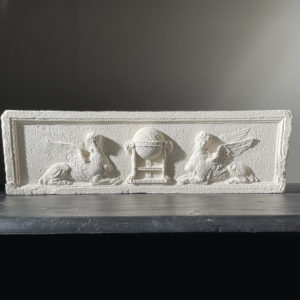
An English plaster relief plaque cast from a George III fireplace tablet,
£155An English plaster relief plaque cast from a George III fireplace tablet,
the rectangular plaque modelled with a central library globe flanked with a pair of opposed winged sphinx ,£155 -
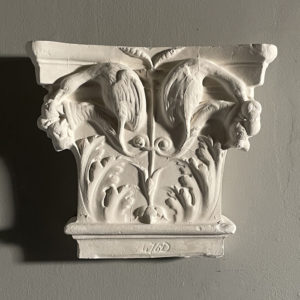
A small cast plaster pilaster capital
£145A small cast plaster pilaster capital
modelled in relief with an opposed pair of cranes each stooping to peck at the fruit from a scrolled cornucopia, acanthine clasps below,£145 -
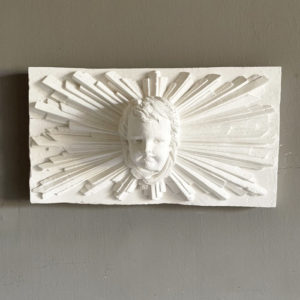
An English plaster plaque of a cherub,
£145An English plaster plaque of a cherub,
the face of the young putto emerging from a dramatic starburst,£145 -
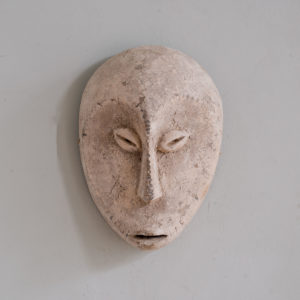
Lega Idimu mask (C)
£140Lega Idimu mask (C)
Similarly to the pipibudze masks of the Kwele tribe, the Lega’s Lukwakongo (miniature) masks have a heart-shaped face framed by a line formed by the nose, the eye rows and the planes of the cheeks. The wooden face is whitened and smoothed with kaolin clay, which is said to allude to the refined and perfected nature of the Bwami initiate, some of whom use the masks during initiation ceremonies. Any holes running around the lower edge of the mask would have held a beard made of natural liana fibres. This mask would rarely be worn on the front of the face, but instead on the side of the face, the forehead, tied to the body, displayed on the fences, or dragged across the floor during Bwami meetings and ceremonies.£140 -
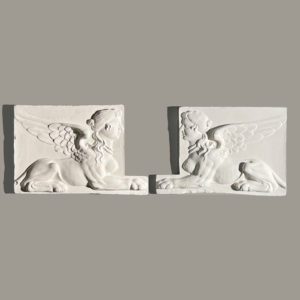
A pair of English plaster relief plaques of opposed Sphinx,
£140 the pairA pair of English plaster relief plaques of opposed Sphinx,
the winged lioness mythical beasts with human heads,£140 the pair -
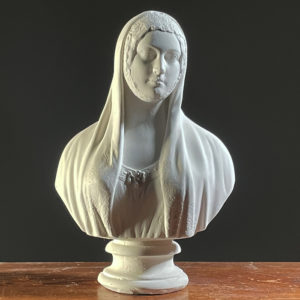
A cast plaster bust of Marguerite Gardiner, Countess of Blessington
£135A cast plaster bust of Marguerite Gardiner, Countess of Blessington
the bust of the Countess attired in a lace bonnet and shawl, her head turned a sinestra, raised on a turned socle,£135 -
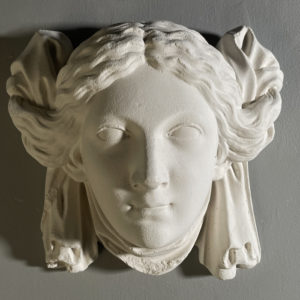
A cast plaster mask of Aphrodite
£135A cast plaster mask of Aphrodite
the classical mask of the goddess with hair blown back, her face framed with swagged drapery£135 -
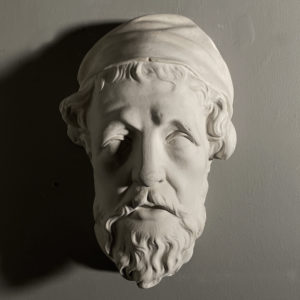
A plaster portrait relief of Inigo Jones,
£135A plaster portrait relief of Inigo Jones,
the mask of the architect in full relief with a mournful expression and full beard,£135 -
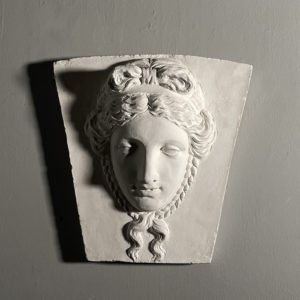
A cast plaster keystone with a classical head of a maiden
£135A cast plaster keystone with a classical head of a maiden
after the Georgian Coade Stone original,£135 -
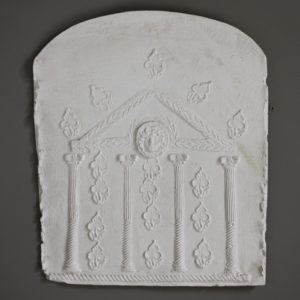
An English plaster cast of the end panel of a Roman sarcophagus,
£130An English plaster cast of the end panel of a Roman sarcophagus,
the relief casting with a triangular pediment supported by four fluted columns and centred with a gorgon mask, with repeating foliate motifs,£130 -
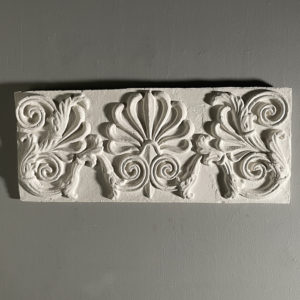
A cast plaster section of frieze with anthemion motif
£130 -
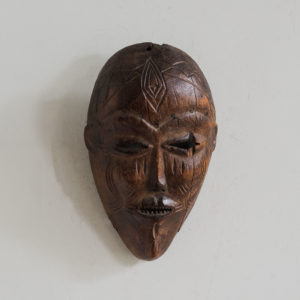
Tchokwe Pwo mask,
£125Tchokwe Pwo mask,
The Pwo is a classic Chokwe mask genre that honours their founding female ancestries as guardians of fertility and procreation. Chokwe masks were made and worn by men, often performed during the celebrations that mark a completion of initiation into adulthood and with means to honour women who had survived the difficulty of childbirth. The occasion is also said to mark the dissolution of intimate bonds between mothers and their sons, which may be represented through the tear carvings and motifs seen on the face. Further, facial scarification as seen on this mask would have been used to make the person less desirable to the spirit of death, and in women specifically would mark the birth of a baby boy.£125 -
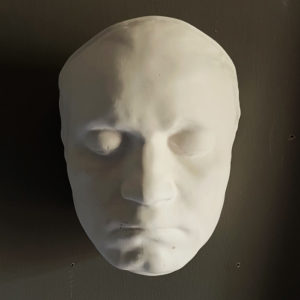
A cast plaster death-mask of Ludwig van Beethoven
£125 -
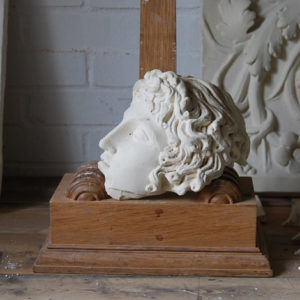
A cast plaster fragment of a classical head
£120 -
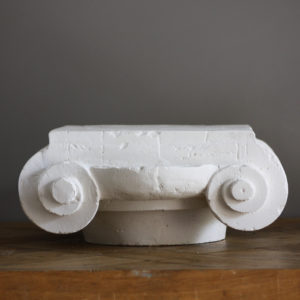
An English plaster cast of a Greek Ionic capital
£115An English plaster cast of a Greek Ionic capital
the square topped capital with scrolled volutes to each side and raised on a circular foot,£115 -
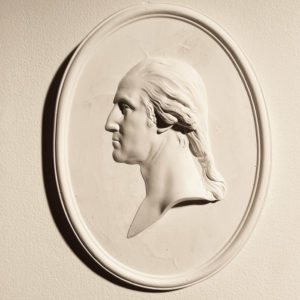
An English relief cast plaster portrait plaque of George Washington,
£115An English relief cast plaster portrait plaque of George Washington,
the bas-relief head in profile on an oval plaque,£115 -
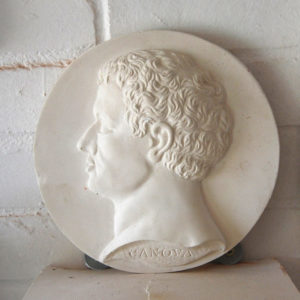
An English relief cast plaster portrait roundel of Canova
£115An English relief cast plaster portrait roundel of Canova
the sculptor depicted in profile, the roundel inscribed "CANOVA",£115 -
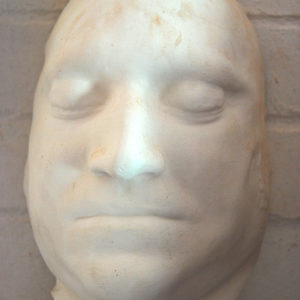
An English cast plaster death-mask of the hanged mutineer Richard Parker
£100An English cast plaster death-mask of the hanged mutineer Richard Parker
Cast at LASSCO Three Pigeons by Peter Hone£100 -
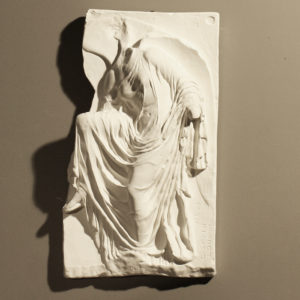
An English plaster cast of The Winged Nike Adjusting her Sandal,
£90An English plaster cast of The Winged Nike Adjusting her Sandal,
the stooping winged figure, cast in relief with a raised knee and attired in dramatically folded drapery,£90 -
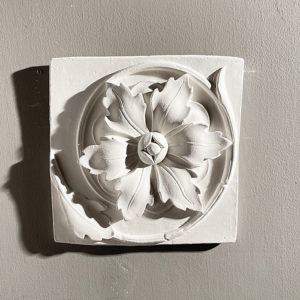
An English cast plaster flowerhead plaque
£85An English cast plaster flowerhead plaque
cast in relief, the flowerhead encircled with a spiralling tendril,£85 -
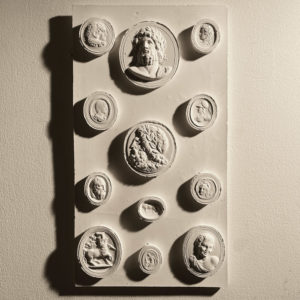
An English relief-cast plaster plaque of intaglios
£80An English relief-cast plaster plaque of intaglios
the rectangular plaque cast in relief with a grid of intaglio ovals comprising portrait miniatures and classically themed intaglios,£80 -
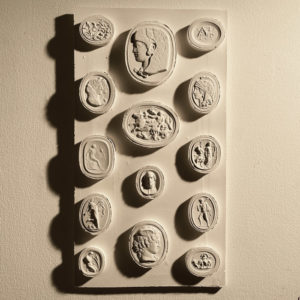
An English relief-cast plaster plaque of intaglios
£80An English relief-cast plaster plaque of intaglios
the rectangular plaque cast in relief with a grid of intaglio ovals comprising portrait miniatures and classically themed intaglios,£80 -
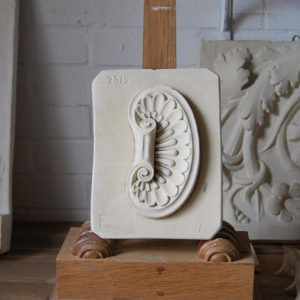
A relief plaster cast of an ornamental cabochon
£75A relief plaster cast of an ornamental cabochon
after a cast by Brucciani and Co. and bearing their stamp,£75 -
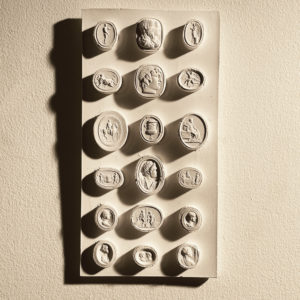
An English relief-cast plaster plaque of intaglios
£70An English relief-cast plaster plaque of intaglios
the rectangular plaque cast in relief with a grid of intaglio ovals comprising portrait miniatures and classically themed intaglios,£70 -
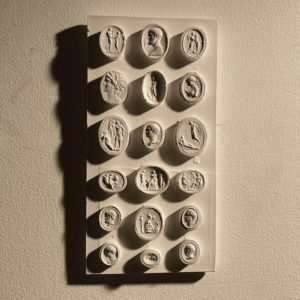
An English relief-cast plaster plaque of intaglios
£70An English relief-cast plaster plaque of intaglios
the rectangular plaque cast in relief with a grid of intaglio ovals comprising portrait miniatures and classically themed intaglios,£70 -
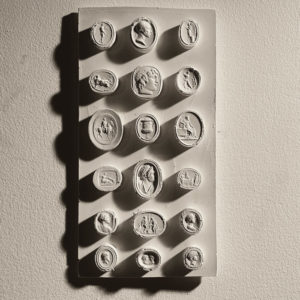
An English relief-cast plaster plaque of intaglios
£70An English relief-cast plaster plaque of intaglios
the rectangular plaque cast in relief with a grid of intaglio ovals comprising portrait miniatures and classically themed intaglios,£70 -
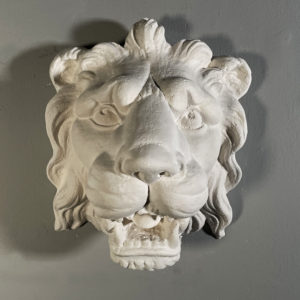
An English relief cast plaster head of a lion
£69 -
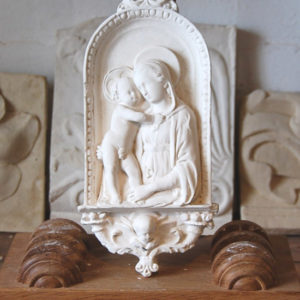
An English relief cast plaster plaque of the Madonna and Child
£66An English relief cast plaster plaque of the Madonna and Child
the two figures modelled in relief within an arched niche, the bracket support below ornamented with armorinii,£66 -
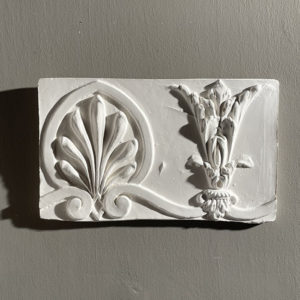
An English cast plaster section of frieze
£65An English cast plaster section of frieze
cast in relief with an anthemion and bundle of acanthus ribbon-tied,£65 -
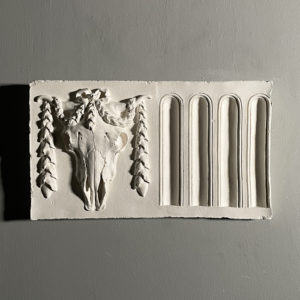
An English relief cast plaster bucranium frieze panel
£65 each tileAn English relief cast plaster bucranium frieze panel
the ox-head skull, with repeating flutes incised to one side to enable the creation of a frieze,£65 each tile -
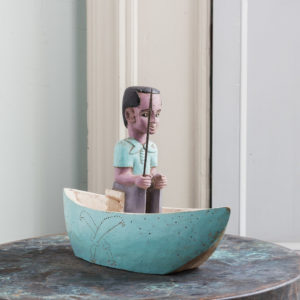
Baoulé Colon figure in a boat,
£50Baoulé Colon figure in a boat,
African colon figures originated among the Ivory Coast’s Baoulé tribe as an often satirical artistic response to colonisation and European influence. The hand-carved wooden statues commonly depict a Europeanised African middle class, or stereotypical attributes of European design - official uniforms, suits, tobacco pipes, distinct hairstyles and hats. The Baoulé waged one of the longest wars of resistance against French colonisation, and the colon style would achieve international popularity following the second World War. The figure depicts a settler travelling sturdily by canoe boat, the two pieces are not attached. Crossed-sword decorative marking motif may have symbolised a readiness to fight evil.£50 -
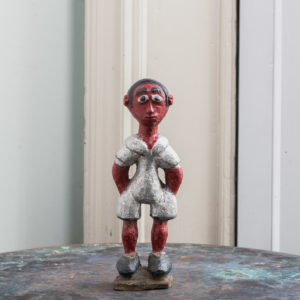
Baoulé Colon figure,
£50Baoulé Colon figure,
African colon figures originated among the Ivory Coast’s Baoulé tribe as an often satirical artistic response to colonisation and European influence. The hand-carved wooden statues commonly depict a Europeanised African middle class, or stereotypical attributes of European design - official uniforms, suits, tobacco pipes, distinct hairstyles and hats. The Baoulé waged one of the longest wars of resistance against French colonisation, and the colon style would achieve international popularity following the second World War. The figure’s clothing style and pigmentation symbolises a distinct sense of European modernity, whereby fashion and status were key symbols.£50 -
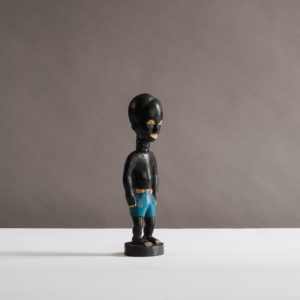
Baoulé Colon figure,
£50Baoulé Colon figure,
African colon figures originated among the Ivory Coast’s Baoulé tribe as an often satirical artistic response to colonisation and European influence. The hand-carved wooden statues involve at least three craftsmen: the sculptor, the sander, and the painter. They commonly depict a Europeanised African middle class, or stereotypical attributes of European design - official uniforms, suits, tobacco pipes, distinct hairstyles and hats. The Baoulé waged one of the longest wars of resistance against French colonisation, and the colon style would achieve international popularity following the second World War. The male figure stands slumped slightly forward, wearing nothing but a pair of brightly coloured blue shorts and belt. European missionaries would encourage African people to ‘cover up’ in order to instil concepts of puritanism and purdor.£50 -
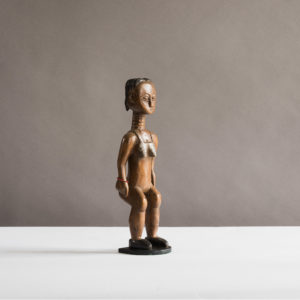
Baule Colon figure,
£50Baule Colon figure,
African colon figures originated among the Ivory Coast’s Baoulé tribe as an often satirical artistic response to colonisation and European influence. The Baoulé waged one of the longest wars of resistance against French colonisation, and the colon style would achieve international popularity following the second World War. Their hand-carved wooden statues commonly depict a Europeanised African middle class, or stereotypical attributes of European design - official uniforms, suits, tobacco pipes, distinct hairstyles and hats. The female figure wears a Europeanised hairstyle, her breasts hidden by a bikini-style top. European missionaries would encourage African people to ‘cover up’ in order to instil concepts of puritanism and purdor.£50 -
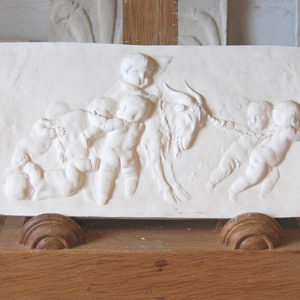
An English relief cast plaster plaque of Putti with a goat
£48An English relief cast plaster plaque of Putti with a goat
the bas-relief depicting the recalcitrant herbivore being man-handled by bacchantic youths,£48 -
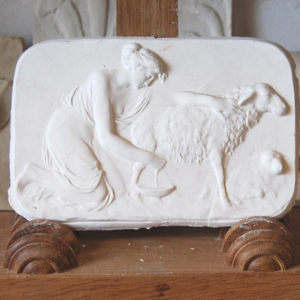
An English relief cast plaster plaque of a Shepherdess milking an ewe
£39 -
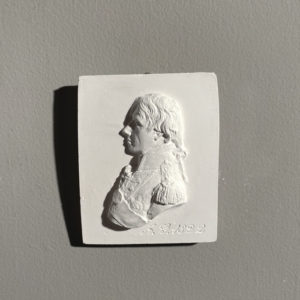
An English miniature plaster portrait relief of Horatio Nelson
£32An English miniature plaster portrait relief of Horatio Nelson
cast in relief, profile bust of the Admiral in dress uniform on a rectangular plaque,£32 -
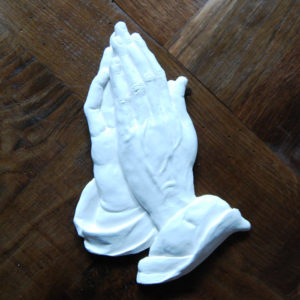
A plaster relief of a pair of praying hands,
£32 -
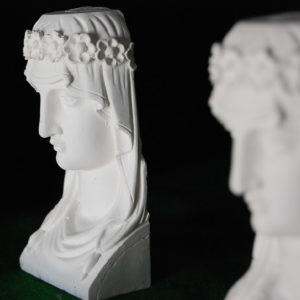
An English cast plaster model of a female Grecian head
£24An English cast plaster model of a female Grecian head
the female veiled head with ringlet hair,£24 -
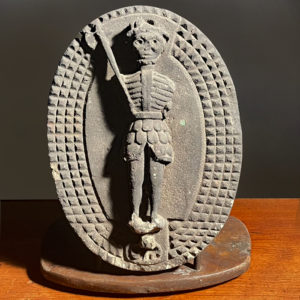
A curious relief-carved sandstone oval plaque
POAA curious relief-carved sandstone oval plaque
carved in relief with a standing figure bearing an axe, raised on a corbel, presented on a radial grid of raised lozenges, mounted on a bespoke oak stand,POA
Featured Items
-
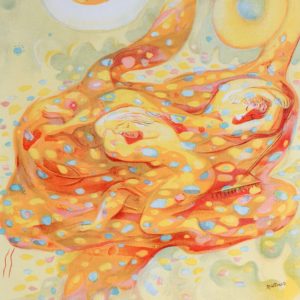
Autumn by Abraham Rattner, Verve Vol. 1 / No. 3.
£600Autumn by Abraham Rattner, Verve Vol. 1 / No. 3.
The Verve Review was a purposefully luxurious. It ran from 1937 to 1960, but with only 38 editions available, due to the high degree of design and editorial work dedicated to each issue. Each edition contained unique lithographic prints, commissioned by the editor, and each cover a double-page lithograph elaborated by one of the artists contained within. It was the brainchild of its editor Stratis Eleftheriades, a Greek National who moved to Paris in the early thirties to take part in the growing Modernist movement, writing under the name of Teriade.£600 -
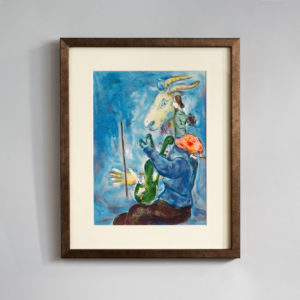
Printemps by Marc Chagall, Verve Vol. 1 / No. 3.
£800Printemps by Marc Chagall, Verve Vol. 1 / No. 3.
The Verve Review was a purposefully luxurious. It ran from 1937 to 1960, but with only 38 editions available, due to the high degree of design and editorial work dedicated to each issue. Each edition contained unique lithographic prints, commissioned by the editor, and each cover a double-page lithograph elaborated by one of the artists contained within. It was the brainchild of its editor Stratis Eleftheriades, a Greek National who moved to Paris in the early thirties to take part in the growing Modernist movement, writing under the name of Teriade.£800 -
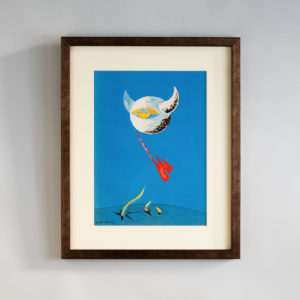
The Moon by André Masson, Verve Vol. 1 / No. 2.
£600The Moon by André Masson, Verve Vol. 1 / No. 2.
The Verve Review was a purposefully luxurious. It ran from 1937 to 1960, but with only 38 editions available, due to the high degree of design and editorial work dedicated to each issue. Each edition contained unique lithographic prints, commissioned by the editor, and each cover a double-page lithograph elaborated by one of the artists contained within. It was the brainchild of its editor Stratis Eleftheriades, a Greek National who moved to Paris in the early thirties to take part in the growing Modernist movement, writing under the name of Teriade.£600 -
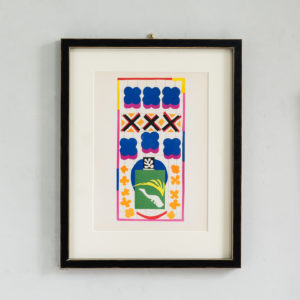
Henri Matisse, ‘The Last Works of Henri Matisse’
£900 eachHenri Matisse, ‘The Last Works of Henri Matisse’
From Verve Vol. IX No. 35/36 published by Tériade under the title 'The Last Works of Henri Matisse'£900 each
